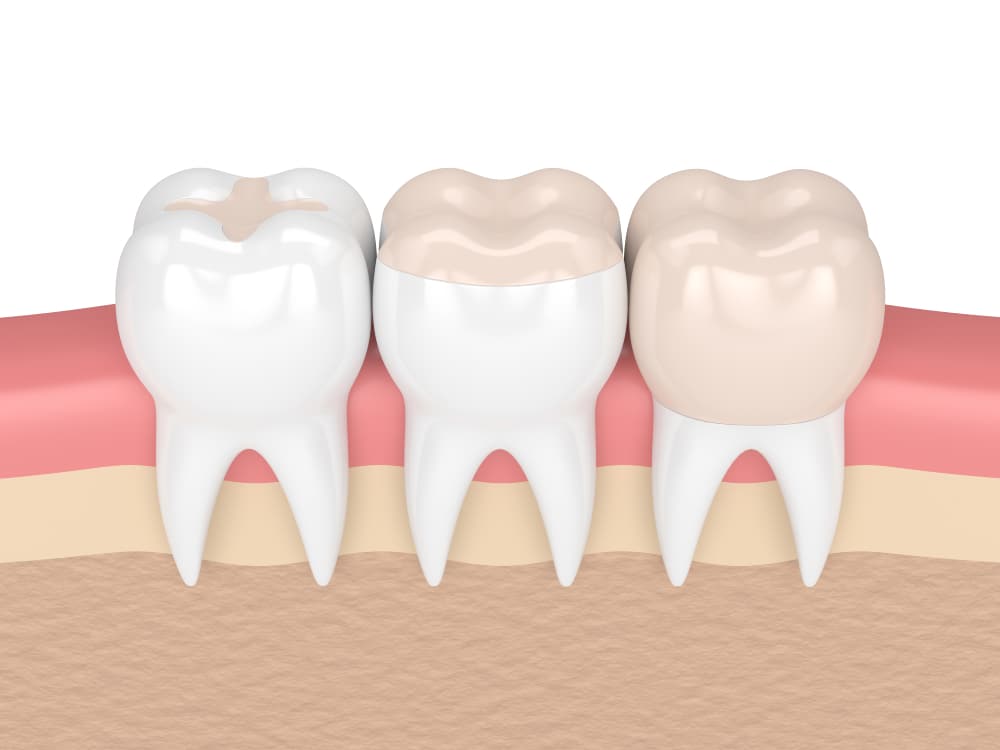General & Cosmetic Dentists Serving Omaha, Bellevue, Lincoln and Nearby Nebraska
Dental inlays and Onlays offer attractive alternatives to fillings and crowns for patients who suffer from certain kinds of structural damage to one or more of their teeth. Inlays and Onlays are fabricated from the same dental material, and the main difference between them is how and where they’re placed.
If you suffer from cracked or chipped teeth, please call The Dentists today at Hillsborough: 402-445-4647, Village Pointe: 402-505-7474, Ralston Square: 402-733-4441, or Dundee: 402-502-5593 to learn more about our cosmetic dentists and to schedule a consultation to discuss dental inlays and onlays.

What Are Inlays & Onlays?
Inlays and Onlays are both dental restoration methods in which porcelain or a composite resin is molded to achieve a certain function. If the material fills a cavity (like a filling), then it is an inlay. If, however, the material is shaped to cover a tooth (like a crown), then it is an onlay.
Both treatments are fabricated according to custom measurements of your mouth. The fit and feel are natural and unobtrusive.
Inlay/Onlay Process
In general, only two office visits are necessary to create and place Inlays or Onlays. In your first visit, one of our cosmetic dentists creates detailed impressions of your teeth and then sends those impressions to a lab for fabrication. Once the inlays or Onlays are ready, the dentist bonds them to your teeth during a second visit. The procedure usually requires only brief use of a mild local anesthetic to ensure patient comfort during the final placement of the inlay or onlay.
Why Should I Choose Inlays or Onlays?
A major advantage of inlays and onlays is that your cosmetic dentist can preserve more of your natural tooth. Unlike some other treatment methods, an inlay or onlay can replace a single cusp of the crown, leaving the remaining healthy portion of the tooth intact. This is an especially attractive benefit for patients whose roots and overall oral health are strong but who have lost a portion of a tooth to some kind of mechanical trauma.
Patients who suffer from mild to moderate tooth decay may, however, not be good candidates for Inlay/Onlay treatment, as severer cases of tooth decay are likely to require a more substantial restoration option like dental implants. Because an implant replaces the entire tooth, including the root itself, it can address certain structural issues that Inlays and Onlays are unable to repair.
What Is the Difference Between an Inlay and an Onlay?

Dental inlays and onlays are great alternatives to dental crowns. While these porcelain caps have an important role in restorative dentistry, they do require patients to take a significant amount of natural tooth enamel off of their natural teeth to place them. With dental inlays and onlays, patients have a more conservative option for restoring the natural tooth. Inlays are placed inside the cusps of the teeth to address an area of decay or breakage, while onlays are placed over these same areas. Both are created with porcelain that matches your natural tooth color and shape and are bonded in place using a special dental cement to seal the tooth and protect it from damage or bacteria.
How Long Do Dental Inlays and Onlays Last?
When you take care of your dental restorations, you can extend their longevity. We educate patients on how to care for their smile to maintain inlays and onlays, which includes brushing, flossing, and visits to The Dentists in the Omaha, NE community. Many of our patients with inlays and onlays who care for them after placement will enjoy them for many years before they need to be replaced by our team.
Are Dental Inlays and Onlays Painful To Get?
At The Dentists, we want every visit to be a comfortable one. When preparing the tooth for inlays, onlays, and other restorations, we will ensure you are at ease and do not feel any pain by offering proper sedation and local anesthetics.
Does Insurance Cover the Cost of Dental Inlays and Onlays?
Dental insurance coverage varies from plan to plan. Because dental inlays and onlays are an alternative solution to fillings for cavities, you may have partial or full coverage for inlays and onlays through your dental insurance plan. However, it is best to talk to your plan provider or work with our front office team to find out if you can reduce your overall cost of these restorations by making the most of your dental insurance plans.
What Materials Are Used To Make a Custom Dental Inlay or Onlay?
At The Dentists, we encourage patients to have inlay sand onlays made from materials such as porcelain or ceramic. These two materials can be made to match in color to the existing teeth and tooth structure and are a way to address oral health concerns while remaining aesthetic in appearance. Porcelain and ceramic look just like natural tooth enamel to ensure discreet results.
How Do I Maintain My Dental Inlays and Onlays After They Have Been Placed?
Your dentist will provide you aftercare instructions to follow closely to maintain your new restorations. For many of our patients, good oral health habits such as routine visits, daily bruising, and regular flossing will not only protect your dental restorations but maintain the health of the entire smile. During dental examinations and cleanings, if our team finds that any dental inlays or onlays are broken or need to be replaced, this will be brought to your attention during your visit.
Dental Inlays and Onlays FAQs
Inlays and onlays offer several advantages over traditional fillings. Unlike fillings that are molded into place within the mouth during your dental visit, inlays and onlays are fabricated in a dental lab before being fitted and bonded to the damaged tooth. This process allows for a more precise fit, which helps maintain the structural integrity of the tooth and prevents further decay. Inlays and onlays are made from durable materials like porcelain or composite resin, which are stronger and last longer than the materials typically used in fillings. Additionally, they are better at sealing teeth than fillings, reducing the risk of further decay.
Recovery after receiving an inlay or onlay is typically straightforward and involves minimal discomfort. You may experience mild sensitivity or soreness in the treated area, particularly if the procedure involved tooth preparation or adjustment of your bite. However, this discomfort is usually temporary and can be managed with over-the-counter pain relievers. Most patients return to their normal daily activities immediately after the procedure. Your dentist may advise you to avoid very hard or sticky foods immediately after the treatment to ensure the inlay or onlay sets properly.
Yes, inlays and onlays are not only functional but can also be used for cosmetic enhancements. They are custom-made to match the color and appearance of your natural teeth, making them a discreet option for repairing decayed or damaged teeth. They can improve the overall appearance of your teeth by covering up staining or reshaping a misshapen tooth, contributing to a more uniform and aesthetically pleasing smile.
If an inlay or onlay becomes loose, it is important to contact your dentist as soon as possible. A loose inlay or onlay is not only uncomfortable but can also allow bacteria to enter under the restoration, leading to further decay. Additionally, a loose piece can fully detach and potentially be swallowed or cause injury. While it may not be an emergency in the traditional sense, it should be addressed urgently to prevent complications.
The length of an appointment for placing inlays or onlays can vary depending on several factors, including the number of teeth involved and the complexity of the procedure. Typically, the process requires two visits to your dentist. The first visit involves preparing the tooth and taking an impression, which is sent to a dental lab to create the inlay or onlay. This visit generally lasts about an hour. The second visit, where the inlay or onlay is fitted and bonded to your tooth, usually takes less than an hour.
Inlays and onlays are made from materials that do not respond to teeth whitening treatments like natural tooth enamel does. If you are considering whitening your teeth, it is advisable to do so before receiving an inlay or onlay. This ensures that the restoration can be matched to the new color of your teeth, maintaining a consistent appearance across your smile.
The cost of inlays and onlays is generally higher than that of traditional fillings but less than full crowns. The exact cost can vary based on the material used and the size of the inlay or onlay. However, considering their durability and the level of protection they offer, inlays and onlays can be a cost-effective solution in the long term. They typically last longer than traditional fillings, potentially saving money on replacements and repairs over the years.
Our dental clinic is proud to be named the best family dentist in Omaha for 17 consecutive years. Our team of experts have a variety of reconstructive and cosmetic specialties, which means we can provide you with a complete and healthy tooth that looks natural in your mouth. Routine visits, daily bruising, and regular flossing will not only protect your dental restorations but maintain the health of the entire smile. During dental examinations and cleanings, if our team finds that any dental inlays or onlays are broken or need to be replaced, this will be brought to your attention during your visit.
Contact The Dentists Today
Our patients who suffer from tooth decay are discovering that Inlays and Onlays offer attractive alternatives to traditional fillings and crowns. If decay has caused your teeth to lose some of their natural structural integrity, dental Inlays or Onlays may be the right solution for you.
Please contact The Dentists today at one of our convenient Omaha locations by calling Hillsborough: 402-445-4647, Village Pointe: 402-505-7474, Ralston Square: 402-733-4441, or Dundee: 402-502-5593. Our dentists serve patients in and around Bellevue, Lincoln and nearby areas of Nebraska. We look forward to serving you, too!